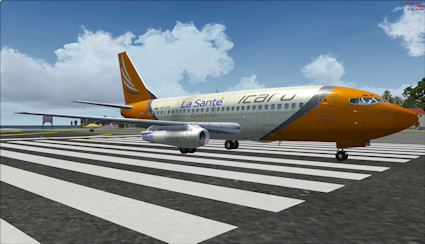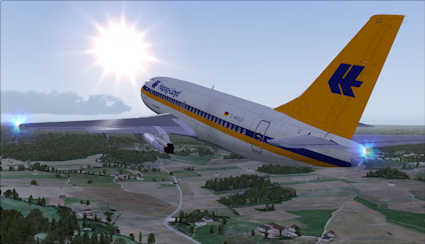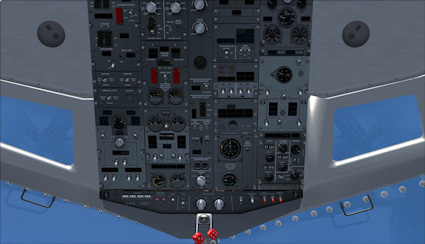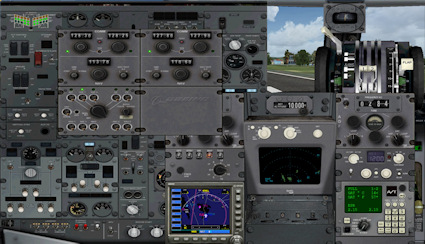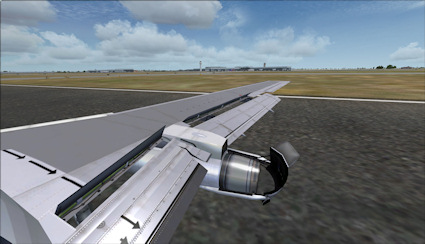It seems, these days, that there are as many Boeing
737's in the sim world as there are in the real world. In fact,
the 737 may be the only aircraft in FSX that can be offered in
every version from the humble -100 series right through to the
super stretched -900ER. That's got to be unusual.
Actually I'm
quite looking forward to flying this version, as I've a thing
for the classics, and the 737-200 is most certainly a classic.
The actual model offered by Just flight is the 737-200adv or
advanced version. Chances are, if you flew to Europe on a package
holiday in the 1980's, it was aboard one of the 200adv variants.
The first 200adv was built in 1971 and it offered major
improvements over the original, including a vastly redesigned
wing and improved engines amongst other things. It proved to be
a popular variant, so much so, that when the last aircraft left
Boeing in 1988, its replacement, the 737-300, had been in
production for four years previously.
Pilots still reminisce
about the Boeing, calling it the best behaved of the whole
series. In fact, of the 1114 -200 series that were built, around
500 are still in service somewhere in the world. So with all
this in mind, I couldn't wait to jump in to the cockpit of Just
Flight's little baby and see what all the fuss was about.
What Do I
Get?
Available in both boxed and downloadable versions,
you get the 737-200Adv with 10 high quality period liveries and
a comprehensive manual. I suspect that new liveries will be
available in the future* as add-on packs that will also provide
the -100 and standard -200 variants for more flight sim fun. For
now though, let's enjoy what we've got.
*As we go to press, Just Flight have released a 737-100
Expansion Pack which provides ten new international airline
liveries as well as the 737-100 model to accompany the 737-200
Advanced.
External
Model
The liveries look very good.
Each aircraft sports dirt and signs of wear. It's not surprising
that the aircraft look dirty, considering how smoky the old
JT8D's were. Just check behind the aircraft at full throttle to
see some rather dirty contrails. It's no wonder that the 200
model is now banned from EU airspace.
Whilst the liveries look good, get too close and the textures start to look blocky and blurry. It's great for FPS but it really lets the side down. At least the moving surfaces look good.
The improved Kruger flaps and increased droop of the outboard slats are shown in fair detail and if you look straight on at the old girl, you'll be able to see the thicker, more aerodynamic engine pylons that the adv featured over its predecessor. That was only a few of the improvements made to Boeing's baby that made the aircraft easier to fly and more importantly, create more lift and thus add more payload.
Into The
Cockpit
From inside, the cockpit is a very intimidating
place if, like me, you've been enjoying the splendour of the
modern 737NG's. Gone are the screens, and in are the many, many
clockwork dials that made up flying in the early days. This
isn't so much 737-200 advanced more 737-Jurassic. (Including
needing Jeff Goldblum as a co-pilot to do the math!) This is
what is commonly called 'steam powered' and I love it! But it is
intimidating.
There are things missing, like a standard FMC and
the autopilot is somewhat of a misnomer. But if you look
closely, you'll also notice that the 737 has changed little
since 1967. The overhead panel is virtually the same, albeit
lacking the modern INS controls, which in a way brings us to
navigation. Think old school. More on that later though, first
let's take a look around.
My initial thought was that the cockpit lacked texture, but I was lucky enough to get a look at a 737-400 cockpit in the flesh recently and I discovered that there really isn't much in the way of texture on the MIP, so I accept what I'm seeing here as a standard look of the classic 737's.
As nice as the VC is though, there area's that suffer from low resolution textures. Whist it's not a deal breaker, coming from the PMDG 737 cockpit, it surprises you a little as to why a better quality texture for the pilots floor for example couldn't be included. Still, it's a small issue in what is a very nice rendition of the 200's cockpit.
Back To The
Future?
Whist the adv seems to mock its own description,
there are signs of modernization's to come. Whilst the now
standard FMC is missing, there's a long lost cousin called the PDCS or
Performance Data Computer System, found on the co-pilots side of
the pedestal. I've never seen one of these before and it sent me
scurrying back to the manual to learn more about it.
The manual does an excellent job of explaining how it all
works, and after an hour or so, I had a much better grasp on how
the whole system works. Whist the workings are simulated well,
the texture for the PDCG is a little flat which just spoils the
look a little. Looks aren't everything though, and it doesn't
take me long to get to grips with the unit. It works in stages,
with a single dial used to select the various phases of flight.
To get started, select TO or take-off. There are a simple set of
pages that just require you to enter the outside air temperature
or OAT. (A quick listen to ATIS will do the trick). Once entered,
the computer works out the EPR or Engine Pressure Ratio for
takeoff. So if we get a EPR reading of 2.12 that means for the
take-off run we need the engines set to this.
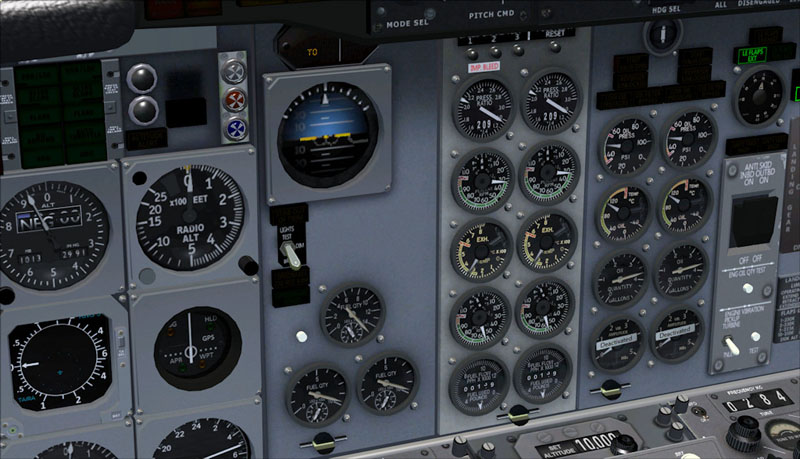 Up close with the steam powered instruments. Note the EPR gauge on the top of the Engine panel. Unique to the early 737's |
The auto-throttle will take care of the flying with the engage button found here, unlike its more modern location on the glareshield. Don't confuse setting the EPR with your 'v' Speeds. I'm afraid you'll need to work those out yourself using your load out figures and the chart of 'v' speeds found in the manual to operate take-off. There are other modes as well that contain all the data you'll need for the climb, cruise, descent and holding in patterns as well as 'Go Around' figures. Essentially, the PDCS operates much as VNAV does on modern aircraft.
There are also a few pages, accessed by using the keypad that can display fuel, wind, temperature, VREF figures and even groundspeed which all help you fly the little Boeing. It's not a complete simulation of the unit, with the odd page just a dummy, but it's still pretty good.
Sperry Cross The Mersey
Whist the PDCS shows signs of evolution, the
autopilot seems little different to that fitted on the Boeing
707 and the 727. The Sperry SP-77 model is an improvement on the
SP-50 unit found in the 727, but by today's standards it's little
different to 'Otto' the inflatable autopilot from the film
'Airplane'.
There are two main controls to the autopilot. One
for the elevators and one for the ailerons. Engaging them during
flight holds the aircraft in that configuration. I've seen it
described as the autopilot takes a snapshot of the controls when
switched on and then holds the aircraft there. And that seems
about right.
On take-off, engaging the autopilot at 1000AGL
results in the nose set at whatever angle you held it at. It was seen as a great way of reducing the pilot’s
workload. However, if you wish to make a turn, you can simply hold
the wheel to the left or right and the aircraft banks left or
right.
Centre the wheel and the autopilot holds the level of
bank you inputted. The same is true for the elevators. Pitch the
nose back or forth and when you release the yoke the aircraft
will maintain the attitude you set. It's a brilliant but simple
system called CWS or Control Wheel Steering. Amazingly, a
version of the SP-77 still exists in every 737 flown today, as
CWS is still included in the modern autopilots.
It's not all CWS though. There are options to select 'altitude
hold' with the pitch controls engaged, as well as a 'turbulence'
mode to help smooth out the ride and hold your altitude. There
are no controls to select a climb altitude just a warning chime
that your approaching your chosen altitude. You can also select
a heading mode with the aileron controls engaged with options
for heading hold or heading select.
Finally there's a very basic
flight director to set to help you navigate. There are options
for VOR lock, auto approach, and manual glideslope. The last two
will enable the autopilot to perform a rudimentary ILS approach
on auto as long as you fly the aircraft the last 200 feet or so
to the ground. In all it's simple, but when properly set, it
allows you to kick back and enjoy your coffee.
In Flight
With the basic systems explained, and some new
knowledge under my belt, I set forth on my first trip.
So I
headed off to London Gatwick to fly a route that I'd flown way
back in 1993 on board a Dan Air 737 to Gibraltar. It has a great
approach that apparently was quite bumpy when I arrived, but I
didn't notice anything untoward. Anyhoo, to the gate.
Sadly there's no Dan Air livery included in this
pack so I plumped for a period British Airways version in the
now gone Landor livery. (Although I would have preferred the
'Negus' version personally).
With the engines off, and the
cockpit cold and dark, I began my pre-flight checklist. Again it
shows how little the 737 has changed over the years with many of
the procedures remaining the same. Here I found my first
annoyance though. From the Overhead view, the yaw damper switch
steadfastly refused to switch during my flow checklist. It will
only switch if the engines are running, unlike the real
aircraft. That irked me slightly. With any luck it'll get picked
up in a service pack. You can of course use the 2D Overhead
panel, where the switch works fine regardless of engine
condition.
Next to annoy
me was the operation of the APU. It seemed to start up a bit
quickly, but more importantly, the APU sound seemed to operate
in ‘on or off' versions.
There's no gradual wind up of the small turbine in the back,
just silence and then it's on. Still the rest of the pre-flight
went well.
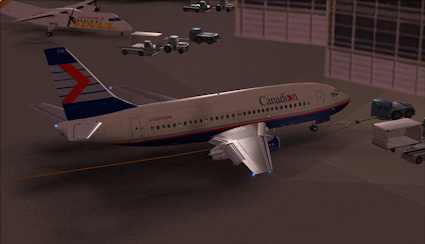 Its nice to see a few names that are no longer with us. |
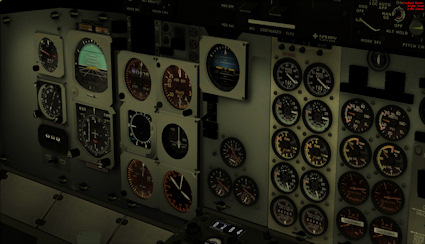 The cockpit Night lighting is not the greatest.. |
Checking my route I discovered that I'd forgotten one important thing. With no FMC to guide the way, navigation was going to be VOR only. Back to school I went as, to be honest, my navigation skills when it comes to VOR's and ADF are poor. It's the price I pay for flying the modern Boeings instead of learning how to fly properly!
Back in the cockpit, I've set the radio to my first nav beacon as well as tuned into Gatwick departure for clearance. Here I found another problem when flying an old aircraft. Unlike the modern cockpits, the 737-200 has no standby frequency available, so if you're using an external radio panel, like the Saitek unit, then remember that the second display is useless.
With everything set, and pushback over I start the engines. The Pratt & Whitney JT8D's whine into life and take me back twenty years in an instant. The high pitched turbine scream is much missed by me. Annoyingly though, starting the engines causes the air con packs to trip out and like the yaw damper switch, the reset doesn't function in the overhead view.
But with everything set, I taxi out to runway 26L and after clearance is given, I advance the throttles to the required EPR setting and we're off. It's very noticeable that the adv is no slouch. That's down to the JT8D's which for low bypass engines are powerful. Pilots use to love the old engines in place of the General Electric CF56's of the modern 737's because the JT8D's spool up almost instantly. At full throttle, the engines really sing and it's gorgeous.
Once in the air it becomes critical to monitor your speed as well as adjusting the PDCS to climb. This will set the bugs on the MIP for climb power.
With a positive rate and the rot set for climb you can engage the autopilot and let the aircraft take the strain. From there on its old school navigation time. If you're flying a SID or Standard Instrument Departure you’ll need a chart and your wits about you. It's certainly a different experience than letting VNAV and LNAV do the work for you whist you tuck into your latte. It's demanding but a hell of a lot of fun.
 The View out over the rear wing at altitude. Note how long the P&W JT8D is compared to modern Engines |
 The moody night lighting seems more Tim Burton than helpful |
Reaching your cruise altitude you can set the PDCS to cruise mode and relax. The maximum service ceiling of 37000 feet is 2000 feet higher than the standard 200 series. Keeping on route requires careful monitoring of your VOR displays, remembering to tune to the next beacon on the route. If you're lucky the VOR LOC will keep you on course.
If VOR navigation is a bit daunting, Just Flight has included a handy switch that will navigate via GPS, just like the default aircraft. You can also access the standard GPS panel via the pedestal 2D panel. There's also a nice rendition of an early moving map display in the centre of the pedestal which doubles as the weather radar. Unfortunately the weather radar part isn't simulated (or I was flying through the clearest air in the world) but the map is a nice addition.
Coming up on the descent things get a little more difficult. When selecting descent from the PDCS you'll get a page to tell you how many miles it will take you to descend from your current altitude to the altitude of the airport you're flying to. So you'll need to keep a view of your route in your head to know your approximate position. You can cheat a little and check the GPS for your position. You can also access your VREF numbers for landing.
Come the time to land I prefer to take control and fly the approach. It's here you can really appreciate the lovely handling of the 737. She's as manoeuvrable as a jet fighter but incredibly forgiving and stable. Bringing the speed down and the flaps extended, she becomes very docile and sluggish.
Touchdown is smooth. Too smooth actually. There doesn't seem to be a touchdown sound at all, leaving you wondering if you're on the grey stuff or not. Once you’re sure you’re on the ground and the reversers kick, in the aircraft stops swiftly. There are no auto-brakes on this aircraft but they were an option for all models.
![]()
Verdict
Boeing know how to build aircraft and the -200 adv
remains at the top of the build list of 1114 aircraft, 1 ahead
of the -300 model. But is the 200 adv a good addition to the
flight sim stable? Yes is the short answer.
It's not without its problems. Well not so much problems
as a lack of polish. There are sound issues, with something's
missing or like the APU, sound not building up properly, the odd
switch being inoperative depending on cockpit state, the V speed
bugs being unmovable unless you set them in the 2D Panel and the
lower quality textures all rob the 200 of its lustre. The gear
lever only operates up and down, but not in the off position.
There's also a missing touchdown sound which can confuse you on
landing.
On the plus side though, the liveries are
very good and the flight characteristics are a joy.
The simulation of both the Sperry autopilot and the PDCS system
are really great. The engine sounds are also good.
So it's not
perfect, but it's a fantastically challenging aircraft. It
certainly made me re-evaluate what thought I knew about flying a
jetliner. I had to go back to school as it were to get the most
out of flying this great period aircraft.
So come on and plunge
in to when flying was a challenge and airlines were full
service. The 200 may be gone from the European skies, but it's
well worth thundering across the virtual skies of flight sim.
Mutley's Hangar score of 8/10
![]()
Jessica Bannister-Pearce
Review machine Spec:
Intel i5 2500K @ 4.5ghz | 8Gb Ram |590GTX
Graphics |Windows 7 / 64bit



